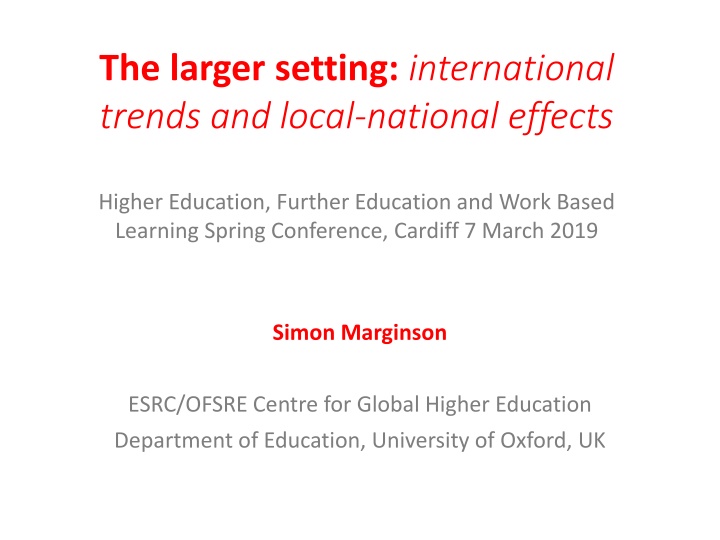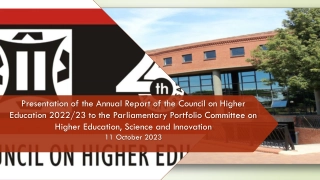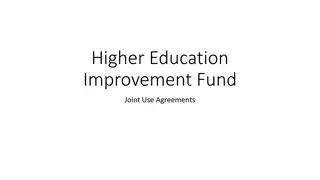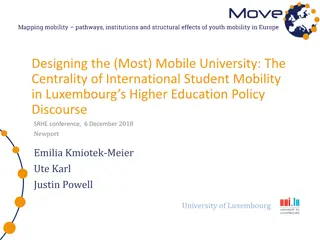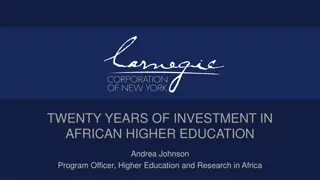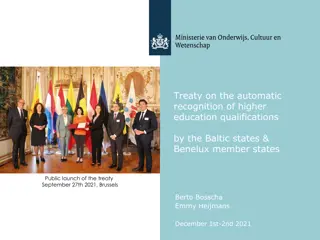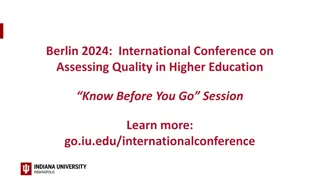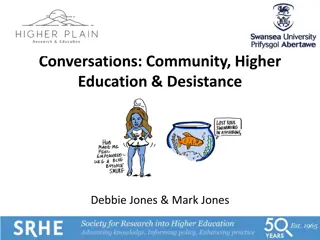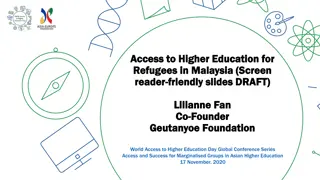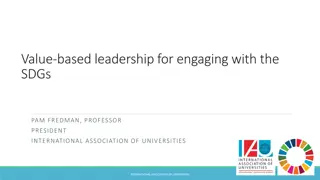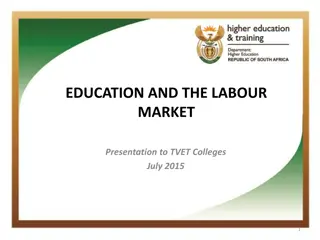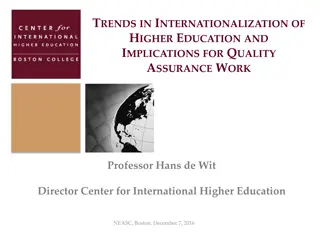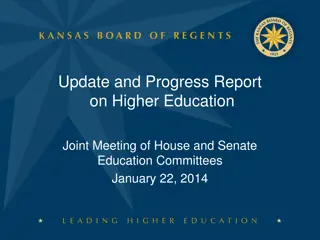International Trends in Higher Education: Key Insights and Implications
Explore the dynamic landscape of international trends impacting higher education, including policy imperatives, growth of participation, cross-border student mobility, research collaboration, and financial sustainability. Gain valuable insights into global income inequality trends and spending on higher education. Discover common global policy imperatives and the evolving role of post-school education in today's society.
Download Presentation

Please find below an Image/Link to download the presentation.
The content on the website is provided AS IS for your information and personal use only. It may not be sold, licensed, or shared on other websites without obtaining consent from the author.If you encounter any issues during the download, it is possible that the publisher has removed the file from their server.
You are allowed to download the files provided on this website for personal or commercial use, subject to the condition that they are used lawfully. All files are the property of their respective owners.
The content on the website is provided AS IS for your information and personal use only. It may not be sold, licensed, or shared on other websites without obtaining consent from the author.
E N D
Presentation Transcript
The larger setting: international trends and local-national effects Higher Education, Further Education and Work Based Learning Spring Conference, Cardiff 7 March 2019 Simon Marginson ESRC/OFSRE Centre for Global Higher Education Department of Education, University of Oxford, UK
The larger setting: international trends and local-national effects Policy imperatives Growth of participation in post-school education Cross-border student mobility Research and research collaboration Brexit and financial sustainability
Trends in global income inequality Theil index: 1990-2010 (a fall in the Theil index indicates that inequality is reducing) 1990 1995 2000 2005 2010 Global inequality 0.949 0.918 0.903 0.827 0.723 Inequality between countries 0.734 0.696 0.681 0.600 0.479 Inequality within countries 0.215 0.222 0.222 0.227 0.244 F. Bourguignon, The Globalisation of Inequality, Oxford University Press, Oxford, 2015, p. 42
Spending on higher education: 2015 current USD, Purchasing Power Parity (UNESCO data) country spending 2015 ($s million) population 2015 Top 50 unis ARWU 2016 Top 500 unis ARWU 2016 United States 239,345 325.7 31 137 data n.a. China 1390.0 0 41 Germany 48,781 82.5 2 38 Brazil 43,176 209.4 0 6 Japan (2017 spending data) 33,817 128.0 2 16 United Kingdom 33,802 61.4 7 37 France 33,641 62.3 2 22 Russia 29,253 136.7 0 3 Turkey 28,858 82.6 0 1 Canada 26,369 35.1 2 19 Mexico 24,420 119.1 0 1 South Korea 16,964 49.1 0 11 Australia 16,928 22.3 1 23
Common worldwide policy imperatives in post-school education Access and participation (focus on social mobility?) Employability of graduates Relations with communities, stakeholders Competition between institutions (not all countries) Expanding role of research Focus on student satisfaction / growth of fee charging Value for money Focus on non-university education (not all countries)
World growth of tertiary education: 1970-2017 1970 = 1.0. World Bank/UNESCO data Four fifths of tertiary enrolments are in degree programmes 8 Tertiary education enrolment 6.7 7 tertiary education students 6 5 4 3 Real GDP 4.2 2 1.0 Population 2.0 1 0 1970 1971 1972 1973 1974 1975 1976 1977 1978 1979 1980 1981 1982 1983 1984 1985 1986 1987 1988 1989 1990 1991 1992 1993 1994 1995 1996 1997 1998 1999 2000 2001 2002 2003 2004 2005 2006 2007 2008 2009 2010 2011 2012 2013 2014 2015 2016 2017
World regional Gross Tertiary Enrolment Ratios (%): 1970, 1990, 2010 and 2017 1970 (%) 1990 (%) 2010 (%) 2017 (%) World 10.1 13.6 29.4 37.9 North America/ W. Europe 30.6 48.8 76.7 78.4 Central and Eastern Europe 30.2 34.2 69.1 80.3 Latin America and Caribbean 6.9 16.8 40.6 50.6 East Asia and Pacific 3.1 7.4 27.9 46.7 Arab States 6.1 11.3 25.5 32.4 Central Asia n.a. 25.4 24.9 26.0 South and West Asia 4.3 5.8 21.2 24.9 Sub-Saharan Africa 0.9 3.0 7.5 9.0
Gross Tertiary Enrolment Ratio (%) World, North America/Western Europe, UK: 1971-2017 90 78 79 80 7777 7878 78 77 74 68697071 7172 70 66 61 5960616160 6061 60 57 54 51 49 50 46 38 3838 38383940 4041 41424344 40 363737 38 36 31323334 313233 10 10 10 111112 12 12 12 12 13 13 13 13 13 13 13 13 13 14 14 14 1415161617 17181920222324242526272829 30 20 10 0 197119731975197719791981198319851987198919911993199519971999200120032005200720092011201320152017 World North America and Western Europe UK
Comparative tertiary participation, OECD using Pat Clancy s Participation Index and OECD data for 2014 100 90 80 70 60 50 40 30 20 10 0 Ireland Canada Portugal Denmark Iceland Belgium Estonia Hungary Netherlands Norway Sweden Turkey Slovak Republic Australia Spain France Slovenia Mexico Finland Poland Austria Germany New Zealand Italy Israel Chile Czech Republic South Korea Switzerland United States UK Higher Education Participation Index Gross Enrolment Rate (%)
Total international/ foreign students in tertiary education, 1998-2016 (millions) OECD data 2018 6.0 5.0 TO OECD COUNTRIES TONON-OECD COUNTRIES TOTAL 4.7 5.0 4.4 4.0 3.9 3.9 4.0 3.6 3.4 3.2 3.0 2.8 2.8 3.0 2.6 2.6 2.4 2.1 2.1 2.0 1.9 2.0 1.0 0.0 1998 1999 2000 2001 2002 2003 2004 2005 2006 2007 2008 2009 2010 2011 2012 2013 2014 2015 2016
Distribution of incoming students: 2016, OECD data United States, 971,417 Belgium, 61,102 rest of world, 1,321,645 UK, 432,001 South Korea, 61,888 Australia, 335,512 Austria, 70,484 Argentina, 75,688 UA Emirates, 77,463 Saudi Arabia, 79,854 France, 245,349 Netherlands, 89,920 Turkey, 87,903 Germany, 244,575 Italy, 92,655 China, 137,527 Canada, 189,478 Russia, 243,752 Japan, 143,547 Malaysia, 124,133
International students, UK: UNESCO data, 1998-2016 500,000 432,001 450,000 419,946 400,000 330,078 350,000 300,000 250,000 225,722 200,000 150,000 100,000 50,000 0
Students entering UK from China, India: 2008-09 to 2017-18, UK HESA data 120,000 106,530 China India 95,090 100,000 91,215 89,540 87,900 83,790 78,715 80,000 67,325 56,990 60,000 47,035 40,000 39,090 38,500 34,065 29,900 20,000 22,385 19,750 19,750 18,325 16,745 16,550 0
International students, United States: IIE data, 1977-78 to 2017-18 1,200,000 1,094,792 total students new students 1,000,000 800,000 623,805 481,280 600,000 356,187 400,000 235,509 200,000 0
International students, Australia: AEI data, 2002-2018 700,000 641,697 higher education VET new higher education 600,000 500,000 363,223 400,000 354,804 300,000 191,828 200,000 100,000 0 VET = Vocational Education and Training
On-shore international students UK, Australia, Canada: 2011, 2015, 2016 2011 2015 2016 United States 709,565 907,251 971,417 United Kingdom 419,946 430,687 432,001 - from Europe 129,564 129,129 141,263 - rest of world 290,382 301,558 290,738 Australia 262,597 294,438 335,512 Canada 120,960 171,603 189,573
Incoming international students from Europe only Tertiary education in United States, UK, Australia and Canada: 2011-2016 UNESCO data
Incoming international students from the world minus Europe Tertiary education in United States, UK, Australia and Canada: 2011-2016 UNESCO data
RESEARCH AND RESEARCH COLLABORATION
R&D as proportion (%) of GDP, 1991-2016: USA, UK, Germany, China, Japan, South Korea 5.00 United States United Kingdom Germany China South Korea Japan 4.50 4.23% 4.00 3.50 3.14% 3.00 2.93% 2.74% 2.50 2.11% 2.00 1.50 1.69% 1.00 0.50 0.00
National investment in R&D, 2016 OECD data, $s billion, constant 2010 USD PPP 500 464.3 450 410.2 400 350 300 250 200 149.5 150 104.1 100 75.9 55.8 42.9 37.2 50 32.5 26.1 24.7 18.0 17.3 16.0 0
Growth in research paper output USA, UK and East Asia, 2003-2016 USA 408,985 321,766 UK 97,527 74,600 Singapore 11,254 6037 Taiwan 27,385 15,807 South Korea 63,063 23,201 Japan 96,536 97,235 86,621 426,165 China 0 50,000 100,000 150,000 200,000 250,000 300,000 350,000 400,000 450,000
Annual number of research papers, USA, China, UK: 2003-2016 500,000 450,000 426,165 411,268 393,963 400,000 362,973 350,000 334,045 332,082 316,915 290,330 300,000 249,973 250,000 215,700 189,760 200,000 164,747 150,000 119,755 100,000 86,621 50,000 0 2003 2004 2005 2006 2007 2008 2009 2010 2011 2012 2013 2014 2015 2016 United States China United Kingdom
Universities with most high citation papers University and country Papers in top 1% 2013-16 citations Papers in top 10% 2013-16 citations Proportion of all papers in top 10% Harvard U UNITED STATES 1096 7305 22.1% Stanford U UNITED STATES 533 3441 22.4% MIT UNITED STATES 429 2616 25.1% UC Berkeley UNITED STATES 355 2557 21.6% U Oxford UNITED KINGDOM 354 2732 18.8% Johns Hopkins U UNITED STATES 337 2698 16.0% U Cambridge UNITED KINGDOM 334 2407 18.4% U Toronto CANADA 326 3088 13.9% U College London UNITED KINGDOM 325 2532 17.8% U Washington UNITED STATES 313 2429 16.8% U Michigan UNITED STATES 308 2806 15.3% UC Los Angeles UNITED STATES 302 2366 17.2% Yale U UNITED STATES 290 2129 18.9% U Pennsylvania UNITED STATES 288 2335 17.6% U Columbia UNITED STATES 273 2192 17.9%
Growth in internationally co-authored science papers, all countries: 2003-2016 600,000 25.0 21.7 20.9 20.2 500,000 19.4 20.0 18.7 17.9 17.5 17.4 17.1 17.0 16.7 16.6 16.4 16.3 400,000 15.0 300,000 10.0 200,000 5.0 100,000 194,398 216,800 243,010 261,100 282,138 299,202 323,334 343,647 370,287 400,381 429,680 464,484 481,060 498,465 0 0.0 total co-authored papers co-authored papers as proportion (%) of all papers
Percentage of papers internationally co-authored: 2003 and 2016 90 80 77 69 70 64 63 62 62 57 60 55 55 53 52 51 51 51 47 50 42 38 37 40 33 31 30 28 30 27 25 21 20 17 20 10 0 2003 2016
High intensity research collaboration UNITED STATES CHINA UNITED KINGDOM Israel 1.33 Singapore 2.03 Ireland 2.16 South Korea 1.23 Taiwan 1.73 Greece 1.74 1.50 China 1.19 Pakistan 1.23 Netherlands 1.43 Canada 1.13 United States 1.19 Denmark 1.43 Taiwan 1.05 Australia 1.15 Hungary 1.40 Mexico 1.04 Japan 1.09 Norway 1.28 Finland 1.27 Italy 1.27 Sweden 1.00 indicates that the number of co-authored publications between the pair of countries is at the level that is expected given their overall rates of collaboration with all countries. 1.50 indicates very high intensity of collaboration relative to the expected level, i.e. a significant bias in favour of that pairing within the overall pattern of cross-border networks. 2.00 indicates relatively exceptional intensity 1.26 Belgium 1.21 Switzerland 1.19 Portugal 1.16 Spain 1.12 Poland 1.07 Germany 1.03 Austria France 1.01 Data - US Science and Engineering Indicators, National Science Foundation 1.35 New Zealand 1.33 South Africa 1.19 Australia 1.01 Chile
Looking ahead: global field will evolve Journey from US hegemony to multi-polarity will continue but American research universities will remain very strong No end in sight to the rise of China. Strategic importance for world society of the Anglo-American encounter with China India will lag in higher education and research yet increasingly, its demography will staff the world s universities US bilingualism may facilitate expanding global role of Latin America. Science in Brazil will advance Saudi Arabia/Gulf States will invest more than perform Russia finds international openness difficult to achieve and may continue to under-perform in science As will Japan, if it does not re-invest UK after Brexit is hard to predict!
BREXIT AND FINANCIAL SUSTAINABILITY
Financial and other implications of Brexit Lost activity Best case Middle case Worst case FINANCIAL Horizon 2020 and other research No change (major net resource gain) UK stays in most, but pays in full Rest of world access only ERDF, EIB and matching funds UK government replaces all funds Selective UK replacement funds All funding vanishes EU student revenues Net gain, enough pay Modest decline affects many Major reduction in many HEIs at higher fee NON-FINANCIAL EU doctoral students No change, flow as Loss of some very bright students Not welcome : big fall in numbers before EU-citizen academic staff Broad High Skill Migration pathway Some loss present and future staff Sharp fall in EU- citizen numbers Study abroad by UK students Erasmus role is maintained UK government mobility scheme Sharp fall in outward mobility European Research Council (ERC) and Marie Sk odowska-Curie Actions (MSCA) schemes will be worth an estimated 1.3 billion to the UK over the next two years. The UK is currently the most successful country in hosting ERC grantees, ahead of Germany, but would immediately become ineligible in the event of no deal.
